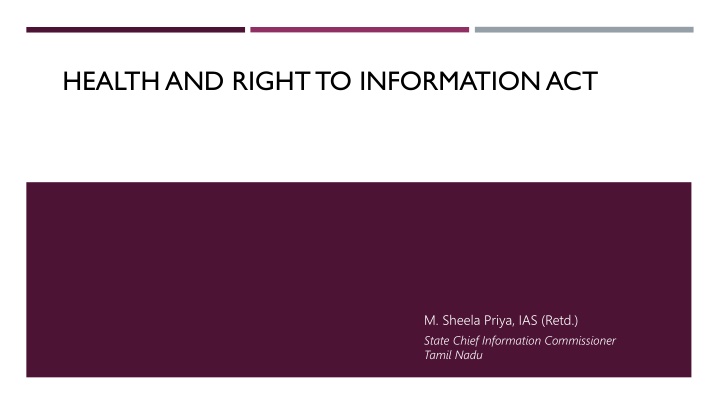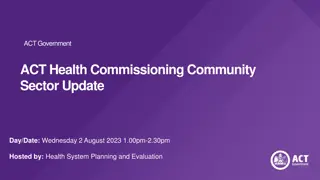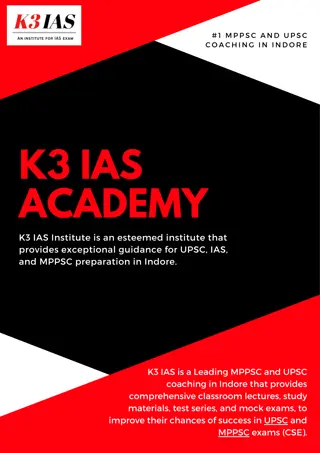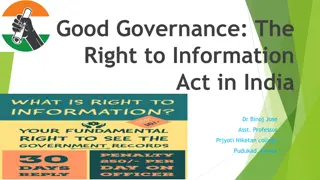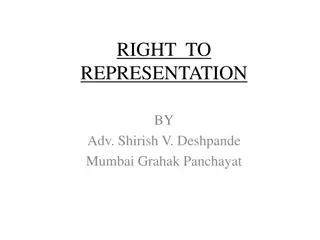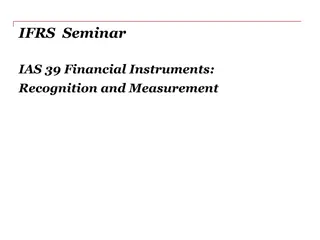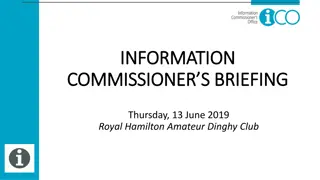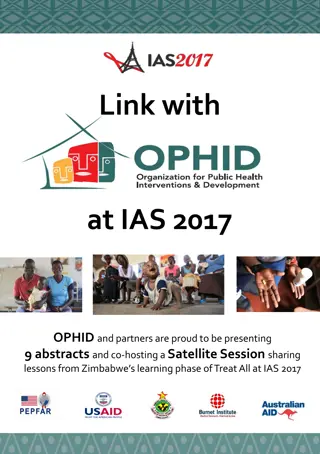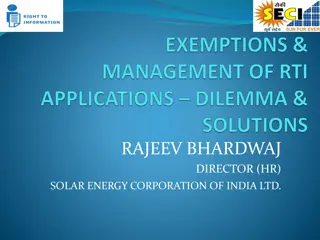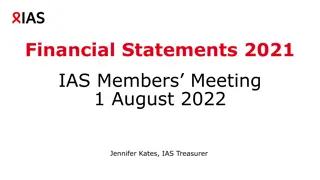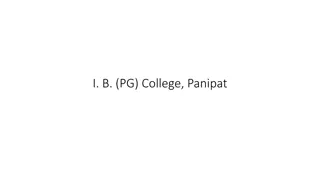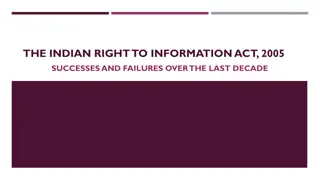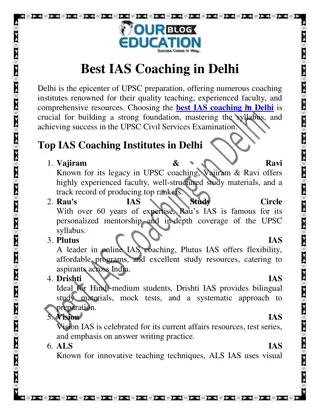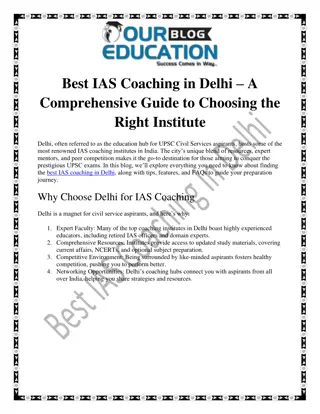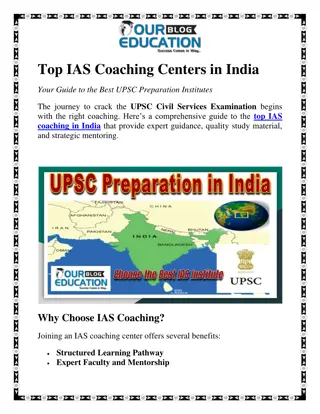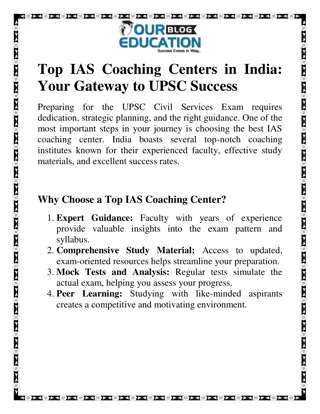Health and Right to Information Act by Sheela Priya, IAS
Providing insight into the Health and Right to Information Act, this document discusses the impact on healthcare bodies, transparency, and accountability in public authorities. It also outlines key healthcare indicators in India and the provisions of the RTI Act of 2005.
Download Presentation

Please find below an Image/Link to download the presentation.
The content on the website is provided AS IS for your information and personal use only. It may not be sold, licensed, or shared on other websites without obtaining consent from the author.If you encounter any issues during the download, it is possible that the publisher has removed the file from their server.
You are allowed to download the files provided on this website for personal or commercial use, subject to the condition that they are used lawfully. All files are the property of their respective owners.
The content on the website is provided AS IS for your information and personal use only. It may not be sold, licensed, or shared on other websites without obtaining consent from the author.
E N D
Presentation Transcript
HEALTH AND RIGHT TO INFORMATION ACT M. Sheela Priya, IAS (Retd.) State Chief Information Commissioner Tamil Nadu
CONTENTS Right to Information Act RTI in a nutshell Healthcare in India Factors affecting health indicators Deconstructing RTI s usage How RTI potentiates numerous healthcare bodies Possible impact & augmentation Making RTI robust
RIGHT TO INFORMATION ACT, 2005 No. 22 of 2005 An Act to provide for setting out the practical regime of right to information for citizens to secure access to information under the control of public authorities, in order to promote transparency and accountability in the working of every public authority, the constitution of a Central Information Commission and State Information Commissions and for matters connected therewith or incidental thereto. AND WHEREAS democracy requires an informed citizenry and transparency of information which are vital to its functioning and also to contain corruption and to hold Governments and their instrumentalities accountable to the governed Good Governance Right to Know Grievance Redressal Transparency Accountability
RIGHT TO INFORMATION (RTI) IN A NUTSHELL Section 25 Monitoring and Reporting Section 4 Suo Motu Disclosures Section 8 Exemption from Disclosure Section 26 Outreach Programmes Public authorities to: Maintain, categorize, index, and computerize records Any information falling under Section 8 (1) (a to j) is exempted to be disclosed under this act Annual reports must be prepared by State/Central Information Commission to be laid before house of parliament/state legislature Encourages appropriate Government to develop and organise educational programmes to the general public on how to exercise the rights under this act Suo Motu Disclosures of organizational information functions & duties directory of officers and employees decision making hierarchy etc. Under second schedule organizations such as Intelligence Bureau, BSF, NSG Directorate of Enforcement are exempted to reveal any information (Section 24) - For each year; no. of requests received, processed, rejected, revenue generated, penalties imposed, actions taken etc. must be furnished by each department every quarter
HEALTHCARE IN INDIA As of 2016, Rs. 52,800 Crores @ 1.12% of GDP Spending IMR Average 34 per 1000 live births Indicators Life expectancy 67.9 years Rates & Life span Estimated to be 2.5% by 2025 MMR 167 per 100000 live births Death rate 6.4% Birth rate 20.4%
FACTORS AFFECTING HEALTH INDICATORS Government/Public Healthcare Planning Citizen s role User Behavioural Aspects Awareness on availability of resources & options Number of healthcare centres Last mile connectivity/accessibility General & health literacy Discerning knowledge between safe & unsafe practices Quality of infrastructure Human Resources Skill levels, number of personnel Participation & Community involvement Preventive healthcare programmes Avoiding quack doctors Financial support, healthcare schemes, insurance, PPP, NGO Increased institutionalized deliveries
CURRENT STATE ANALYSIS DECONSTRUCTING RTIS USAGE TRANSPARENCY, ACCOUNTABILITY Suo Motu Section 4 Section 25 EXPECTED PARADIGM SHIFT R T I PRESENTLY DOMINATED ROUTE CIC & SIC Three tier structure to provide info on request GOOD GOVERNANCE, CURB CORRUPTION
Grievance Redressal (Reactive) Suo Motu (Proactive) Paradigm shift from grievance redressal to information dissemination tool Awareness and health literacy is central to improving healthcare indicators Preventive healthcare produce greater impact whilst expending lesser resources funds, manpower etc. Suo Motu disclosures can enable RTI to integrate goals, functions & objectives of various healthcare bodies and framework envisaged by GoI Achieve higher adoption of NRHM schemes, increase insurance coverage HOW RTI CAN POTENTIATE VARIOUS HEALTHCARE FRAMEWORKS
NHSRC CBHI NHRM DGHS CHC/PHC/ SHC/DH Increasing Awareness, health literacy & community participation CITIZENRY RTI SUO MOTU DISCLOSURES Information on healthcare facility, schemes, insurance, curbing quack doctors Govt. Insurance Scheme Clinical Establish- ment Bill
Curbing corruption Educating women to derive the fullest out of JSY schemes and its financial incentives will increase institutionalised deliveries and therefore reduce IMR & MMR By knowing exact benefits through Suo Motu disclosures, not only via internet, but also through panchayat meetings can curb corruption & middle men Insurance Schemes NHP 2017 indicates 35 crore individuals have health insurance i.e. 27% of our population. More than 80% of them are under central govt. scheme Through RTI disclosures, larger adoption in RSBY, Rashtriya Arogya Nidhi, TN CM Comprehensive Health Insurance Scheme, Gujarat CM Amrutam etc. can be achieved. Demanding healthcare rights/Curbing quack doctors Clinical Establishment Act regulates medical infra owned/managed by govt., trust, private including single doctor clinic RTI disclosures can reveal minimum standards & infra that patients deserve This can help promote AYUSH while curbing quack doctors POSSIBLE IMPACT FROM RTI IN HEALTHCARE
MoHFW has notified standards for Electronic Health Record (EHR) 2016. Digitization of records minimizes human error. Helps retrieve critical life saving information instantly. CLINICAL EST. BILL HMIS What is measured is managed! Health Management Information System (HMIS) tracks quantitative aspects about HR, Infra, Medicine Stock etc. at every CHC, PHC etc. EHR RTI Disclosure of reports, engaging ASHA workers, panchayat boards, local community to tackle practical difficulties will enable improved operational efficiency NRHM Disclosing health indicators, improving health literacy, incentives etc. will improve efficacy of NRHM schemes PHC/CHC INFRA QUALITY AUXILLIARY AUGMENTATION EHR, HMIS, CEB
MAKING RTI ROBUST CURRENT LIMITATIONS FUTURE AREAS FOR IMPROVEMENT Section 25 reporting and monitoring focusses excessively on quantitative aspects no. of requests to each PA, processed vs. rejected etc. Identifying qualitative aspects of the RTI queries will enable proactive measures by addressing root causes Lack of external audit on CIC & SIC & all PA s to comply with annual reporting. E.g.: CIC last annual report was from 2015-16, TN SIC 2014-15. Pareto Analysis Case Tags 80% of cases should statistically arise from 20% of the causes. Identifying root causes can help in proactive actions Promote RTI Classifying nature of RTI request (Funds, quality, vacancy, grievance, public welfare etc.) with each PA External Audit Under section 26 Increasing budget allocation Ensuring compliance of all PA s under section 25 of RTI act
